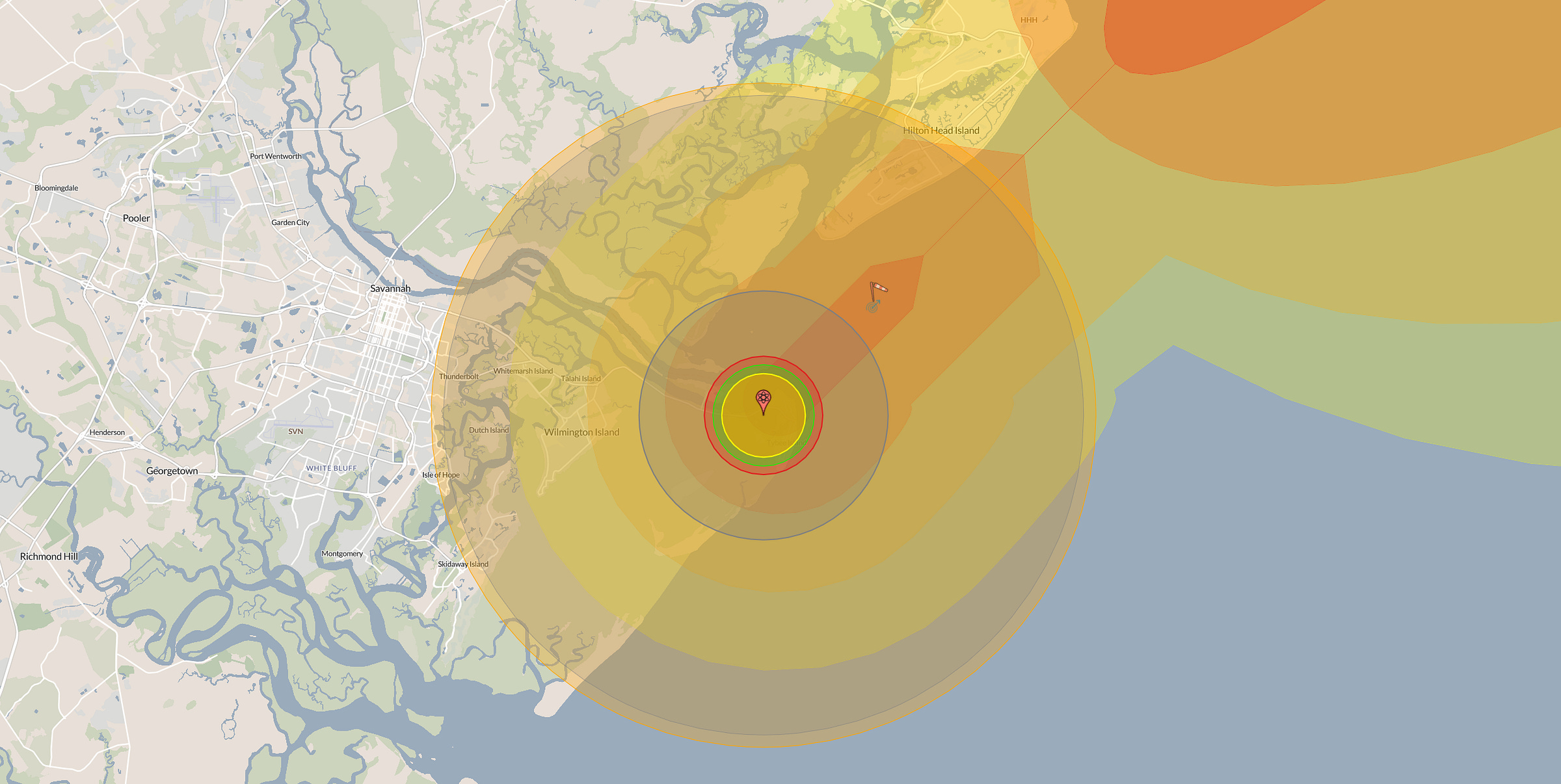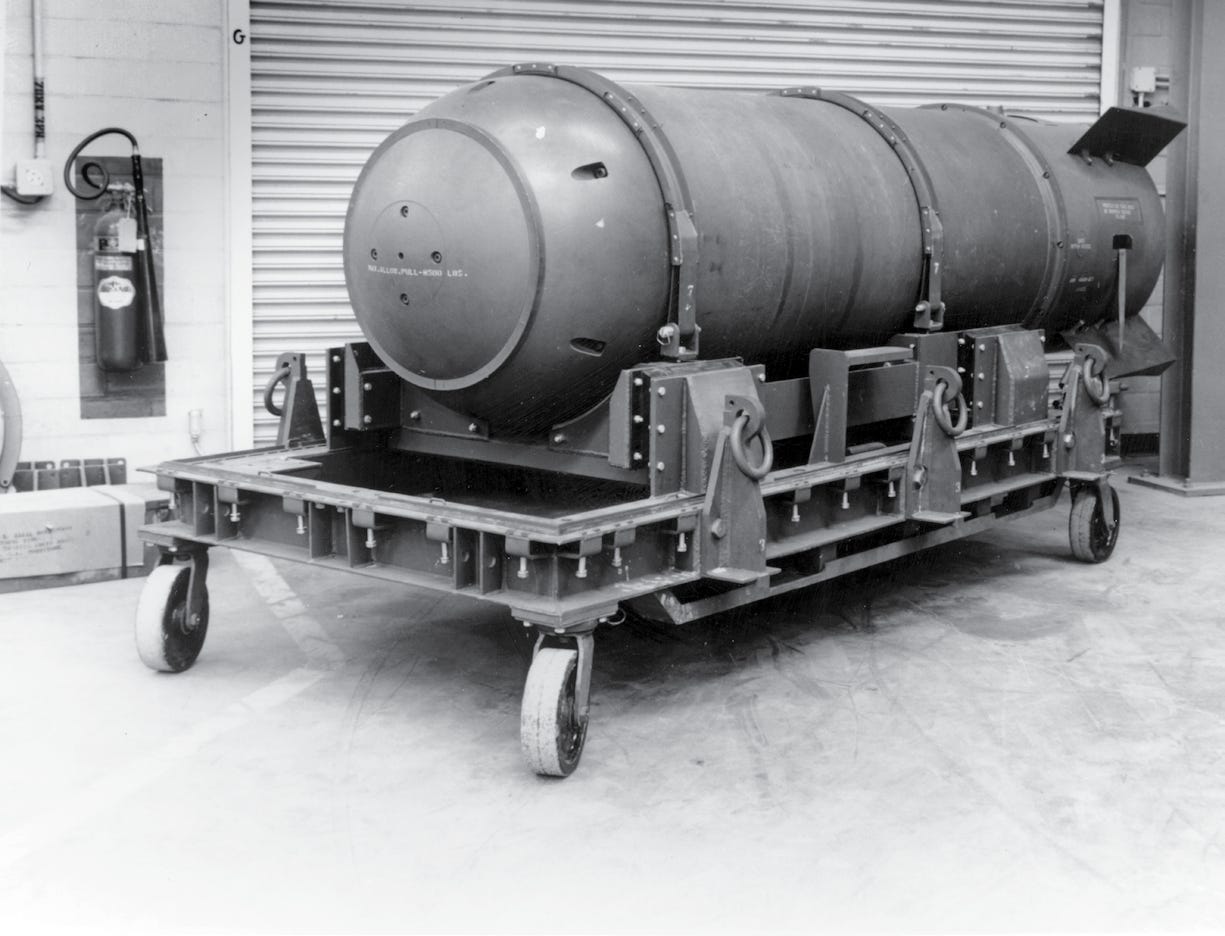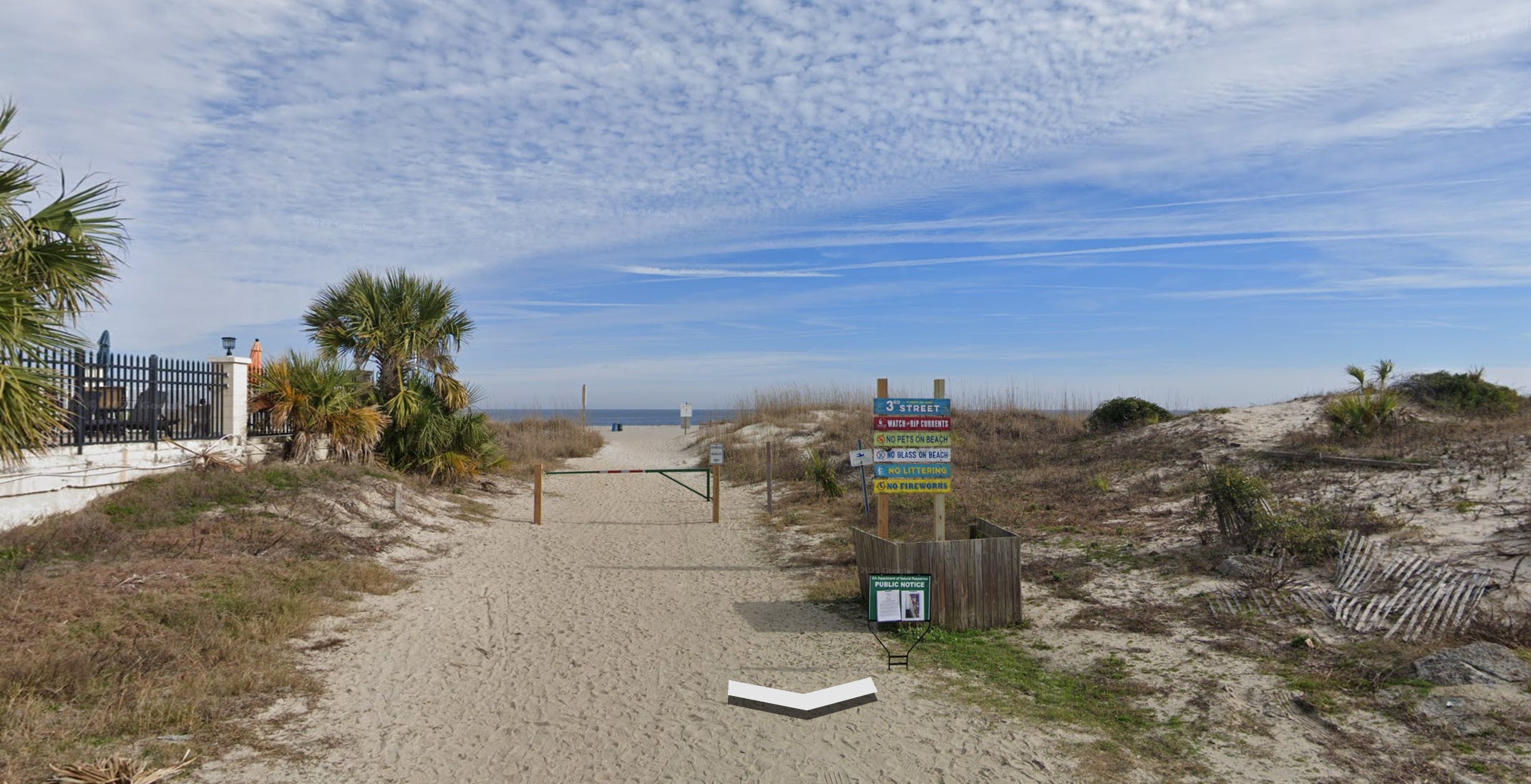Savannah’s Sleeping Giant: The Nuclear Bomb the US Air Force Never Recovered
The devil went down to Georgia.
The United States has lost a handful of nuclear weapons over the decades, but only one of them has a fan club, a parade float, and multiple half-drunk eyewitness accounts from shrimpers who swear they nearly dragged it into shore.
That bomb sits beneath the gray-green churn off Tybee Island, Georgia. Seventy years later, it remains the strangest Cold War mystery east of the Mississippi.
And yes, if it were armed and detonated today, it could vaporize half of Savannah and spread fallout up the Atlantic coast as far as North Carolina.
Welcome to the saga of the Tybee Bomb.
The Night the Air Force Misplaced a Thermonuclear Device
On February 5, 1958, a B-47 Stratojet was limping home from a simulated bombing run. Its crew had just spent the night pretending to erase Radford, Virginia from the map, because apparently nothing says “good training value” like practice-nuking Appalachia.
Their aircraft was carrying a Mark 15 Mod 0 hydrogen bomb.
Rough yield: 3.8 megatons.
I hate the equivocation “That’s roughly 190 times the blast power of the bomb that destroyed Nagasaki,” so I’ll just say it’s powerful enough to give you a real bad day unless you’re wearing SPF 6,000 sunblock.
Then fate barreled in from above, literally. An F-86 Sabre from Charleston clipped the B-47 during a simulated interception. The collision tore the Sabre apart, and the F-86 pilot, Lt. Clarence Stewart, parachuted into a swamp on the South Carolina side of the Savannah River.
Stewart survived frostbite, a swamp landing, and the indignity of having a flare gun misfire at his toes before a local ranger hauled him out. The man spent part of the night hiding from imaginary alligators and drinking medicinal moonshine.
While Stewart was being rescued, the B-47 crew wrestled their wounded jet and its nuclear payload toward Hunter Air Force Base. But Hunter’s runway was partially torn up for repairs, and the crew knew the math: hit the uneven concrete too hard and the Mark 15 could rip loose inside the aircraft like a sledgehammer the size of a Volkswagen.
The Air Force had a decision tree for this exact scenario. Step one: save the crew. Step two: ditch the nuke. Step three: don’t blow up Georgia.
So Major Howard Richardson eased the bomber out over the open water and dropped the 7,600-pound weapon into the sea just off Tybee Island. No explosion. No shockwave. No plume. Just a heavy splash and a sinking feeling.
Richardson brought the B-47 home safely and earned the Distinguished Flying Cross.
His bomber, battered beyond salvation, never flew again.
What They Lost: A Four-Megaton Warhead Built to Level Cities
To understand the unease around the Tybee Bomb, you have to picture the Mark 15 as it existed in 1958: a weapon engineered for one purpose, and one purpose only: to erase an enemy city so thoroughly that the target map would need a new coastline.
The Mark 15 wasn’t a tactical nuke or a battlefield firecracker. It was a strategic hydrogen bomb, the kind SAC crews trained to carry across the Arctic and arm in the final minutes before releasing it over a Soviet port or industrial hub.
At full yield, the warhead packed enough energy to turn several square miles of urban landscape into incandescent gas. The word “vaporized” doesn’t do justice to the atomic destruction this thing would cause to the human body. “Disintegration” would be slightly more appropriate; that is, disintegration faster than your nervous system could communicate that you were being disintegrated.
The thermal pulse alone was designed to blind crews who looked at it directly, ignite everything flammable within a vast radius, and push a shockwave outward with enough force to fold steel like cardboard.
One of these devices was sufficient to neutralize a target the size of a metropolitan district.
The Mark 15 existed in an era when the United States expected nuclear war to be fought in salvos, not single strikes.
Even so, losing one was never supposed to happen.
The heart of the bomb was where the uncertainty still lives. A thermonuclear weapon is only as dangerous as its physics package like the internal stack of explosives, uranium, and (potentially) the plutonium pit that initiates the fusion reaction.
The Air Force’s long-standing position has been that the B-47 was flying with a training configuration: full casing, full weight, but no pit. That would make the Tybee Bomb a very large container of high explosives and enriched material, hazardous in the wrong hands but incapable of producing the characteristic sunburst of a true hydrogen detonation.
But the paper trail complicates that claim.
The 1966 Congressional note describing the device as “complete” introduced a long shadow the Air Force never fully dispelled.
“Complete” didn’t refer to the paint job. It was shorthand inside the nuclear weapons complex for a weapon that had all required components to function as designed. That tiny contradiction, a single word buried in post-incident paperwork, is why historians keep circling this story.
It suggests the possibility, however remote, that the crew jettisoned a war-ready hydrogen bomb into coastal water barely ten miles from shore.
Even in a non-nuclear scenario, the danger wasn’t trivial. A thermonuclear device that size contains conventional explosives strong enough to rupture the seafloor if accidentally disturbed.
Its radioactive metals, if exposed or dispersed, could contaminate the waterway, the fisheries, and the barrier islands that define the Georgia coast. Everything about the Mark 15 was built for destructive efficiency.
And somewhere beneath the silt, that efficiency is still waiting.
Broken Arrow: The Cold War Had Its Own Euphemisms
The Air Force spent two months searching for the lost bomb with sonar sweeps and Navy divers. They found Civil War cannonballs, abandoned scrap, and suspiciously little else.
By April 1958, the military called off the effort.
The Pentagon labeled the incident a “Broken Arrow.” Bureaucratic shorthand for “lost nuke, but please stop asking questions.”
Rumors began almost instantly. Some locals swore they spotted a Soviet submarine lurking offshore. Whether Moscow hoped to salvage an American warhead is unclear; whether they succeeded is even less so.
If the Kremlin did recover it, we never found any evidence when the Soviet Union collapsed or from the legendary Mitrokhin Archive.
But the broader truth was obvious: the Tybee Bomb hadn’t been found, and the search wasn’t getting any easier.
To understand how a megaton-class hydrogen bomb ended up at the bottom of coastal Georgia, you have to understand the airplane that carried it.
The B-47 Stratojet was a Cold War thoroughbred; a flying dart with swept wings inspired by captured German aerodynamic research. It was sleek, fast, and revolutionary, but also temperamental and dangerously ahead of its time.
Jet engines in the late 1940s weren’t known for reliability. The B-47’s thin wings flexed like the arms of a yoga instructor. Its landing speeds were brutal. Its safety record was alarming.
In 1958 alone, the Air Force lost 33 B-47s to accidents.
This wasn’t “plug-and-play aviation.” It was a high-speed negotiation with physics.
So, when the B-47 over Tybee started shedding hydraulic fluid, Richardson knew he was one bad bounce away from disassembling the bomb inside his own aircraft. Most nuclear accidents fade into classified archives and dusty footnotes. The Tybee Bomb did the opposite. It quietly burrowed into coastal folklore.
Tybee Island embraced the oddity. There was even a parade float in 1998 featuring swimsuit-clad women straddling a mock bomb like Slim Pickens in Dr. Strangelove.
Then the shrimpers got involved.
For decades, fisherman Bubba Smith insisted he snagged “something heavy” near the Tybee fishing pier around 1960. Heavy enough to snap gear and warp his rigging. When he hired a diver, the man resurfaced screaming one word:
“Bomb!”
Bubba cut the net and left the object where it was. His dying wish was that someone retrieve it before his granddaughter grew up and found herself glowing in the dark.
Whether Bubba dragged the Mark 15 across the seafloor or hooked a derelict engine block is anyone’s guess. But the story stuck, because this coast is riddled with shipwrecks, lost cargo, Civil War artifacts, and enough half-believable legends to make that Ancient Aliens guy on History Channel blush.
The Tybee Bomb is just the region’s most dramatic entry on that list.
The Man Who Went Looking: Lt. Col. Derek Duke
Cold War mysteries have a way of attracting true believers. For the Tybee Bomb, that man was Lt. Col. Derek Duke, a retired Air Force pilot, commercial flight instructor, and amateur nuclear archaeologist.

After reading declassified testimony naming the Mark 15 as a “complete weapon,” Duke began searching the Wassaw Sound area with magnetometers and Geiger counters.
At one point he claimed elevated radiation. The Air Force politely disagreed, calling it naturally occurring minerals.
Duke remained unconvinced.
He argued that the bomb’s plutonium core must have been installed on the ground because the B-47’s cramped internal bay didn’t allow for in-flight arming procedures. He cited former weapons handlers who swore they never loaded these bombs without their pits.
The Air Force pushed back. Richardson himself, the pilot who later became a colonel, wrote an op-ed calling claims of a fully armed nuke a “disgraceful fraud,” insisting no capsule was on board.
And so, the argument remains frozen in time: a missing 7,600-pound hydrogen bomb, with contradictory official and unofficial testimony, and no hard evidence either way.
If the Mark 15 does contain its plutonium pit and remains intact, a surface detonation would incinerate everything within roughly a mile, cause severe burns miles beyond that, and blast fallout across the Lowcountry and up the Atlantic coast.
Savannah would be cut in half. Prevailing winds could spread contamination toward Charleston or up to North Carolina.
The US government maintains there is no risk. Critics remain unconvinced.
Both sides agree on one thing: the bomb is buried under five to fifteen feet of silt and digging it up might do more harm than leaving it alone.
So, it stays where it is… lost, silent, and unsettling.
The Sea Keeps Its Secrets
There’s a rule along the Georgia and South Carolina coast: the ocean gives back what it wants, when it wants.
Some days that’s a shrimp haul. Some days it’s Civil War cannonballs. Some days it’s the wreck of a schooner nobody remembers.
But a 7,600-pound thermonuclear device? That’s a secret the marsh seems determined to keep.
And somewhere beneath the dark water, something heavy sleeps.
There are many kinds of Cold War legacies.
Some sit in museums.
Some gather dust in hangars.
And a few lie in the seabed off Tybee Island, wrapped in silt, legend, and a silence thick enough to be unnerving.
Whether the Tybee Bomb is a benign relic or a fully armed hydrogen device remains officially unanswered. What is certain is that it shaped the mythos of an entire coastline and stands as a reminder that even superpowers sometimes misplace things they shouldn’t.
Thanks for reading,
W






